unit1 hello备课笔记
3AUnit1Hello第一课时
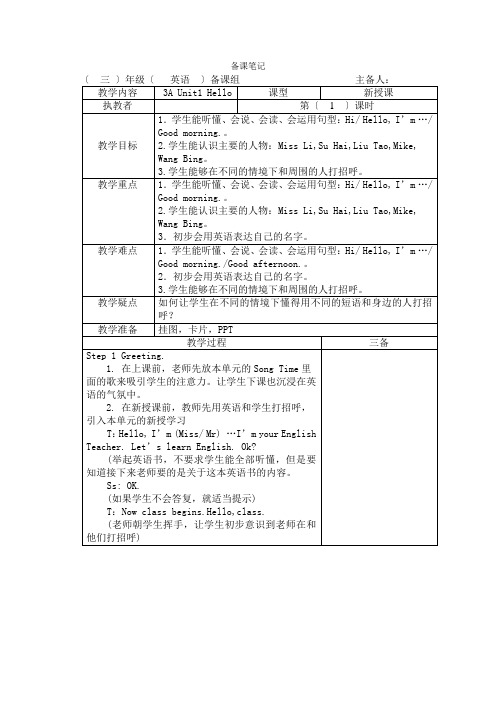
备课笔记T:Look,who is she/he?(可以提示中文,让学生明白who 用来问谁,也让学生慢慢接触who 后填主人公名字,帮助学生以后自己学习。
)Ss:Miss Li/Mike…T:What are they saying ?(同样可以提示中文,让学生熟悉这样通过疑问词来自学课文的方式。
)PPT显示课文图片 (分别显示在每幅图的边上):例如:What:Who:Miss LiWho:MikeWhat:T:Now,please listen to the tape,and find the answers.(放录音,让学生去听)T:Now who can tell me what Mike is saying? (用手指着对话框,有些学生也许前面没有完全理解) S:Good morning,Miss Li.教师出示Good morning.教授句子Good morning. T:Please read after me,Good morning.a.全班一起读b.个别读/One by one(纠正个别学生的错误发音),师生用这个句子进行对话练习。
c.再全班读跟读录音第一幅图T:Now,please read after the tape,picture 1.B.Picture 2 and 3a.T:Now Please listen to the tape ,and find what they are saying.PPT出示课文图片2 和3,让学生去听,找答案。
S:Hi,Mike.T:Hi equals Hello.教师出示Hi.=Hello.(你好。
)T:Now ,I’m Mike.Please say Hi ,Mike.S1:Hi,Mike.T:Hi.(这个比拟简单,这一局部练了及个来回然后全班读一下就可以一带而过)T:Can you act picture 3?(教师拿出Mike 的头饰给学生,指着第三幅图,让学生明白让他们表演)d.全班跟读录音,第二和三幅图。
六上英语人教版unit1笔记

Unit 1 Hello!一、词汇1. 尊称:name2. 你好:hello3. 问候:greeting4. 再见:goodbye二、句型1. 你好,我是李明。
Hello, I'm Li Ming.2. 再见,老师。
Goodbye, teacher.三、对话A: Hello, I'm Li Ming.B: Hi, Li Ming. I'm Amy. Nice to meet you. A: Nice to meet you, too.B: Goodbye, Li Ming.A: Goodbye, Amy.四、语法1. 句子的基本结构:主语+谓语2. 动词 be 的用法:am, is, are3. 形容词的位置:在名词前面4. 人称代词的用法:I, you, he, she, it, we, they5. 介绍自己的句型:Hello, I'm + 尊称。
6. 说再见的句型:Goodbye, + 对方的名字。
五、笔记复习1. 温故知新通过复习,加深对词汇、句型和对话的印象,巩固基础知识。
2. 刻意练习反复练习对话,提高口语表达能力,增加语感。
3. 合理安排时间控制复习时间,避免长时间枯燥的学习,保持专注力。
4. 看图说话通过图片复习词汇和句型,增强记忆效果。
5. 互相交流与同学互相复习,用英语交流,提高学习效率。
六、总结通过本单元的学习,我学会了英语的基本问候和介绍方式。
我对英语的人称代词、动词 be 的用法以及形容词的位置也有了更深的了解。
在以后的学习中,我会继续加强对这些知识点的掌握,不断提高自己的英语口语表达能力。
感谢老师的教导,让我有了更好的英语学习体验。
以上是我对六上英语人教版Unit 1 的笔记总结,希望对大家有所帮助。
在上面的基础上,我还想补充一些关于英语学习的方法和技巧。
七、学习方法和技巧1. 多听多说在学习英语时,尽量多听一些英语的材料,比如英语歌曲、英语电影、英语广播等,这样能够锻炼自己的听力和口语表达能力。
最新三年级上第一单元Hello!课文知识点整理资料
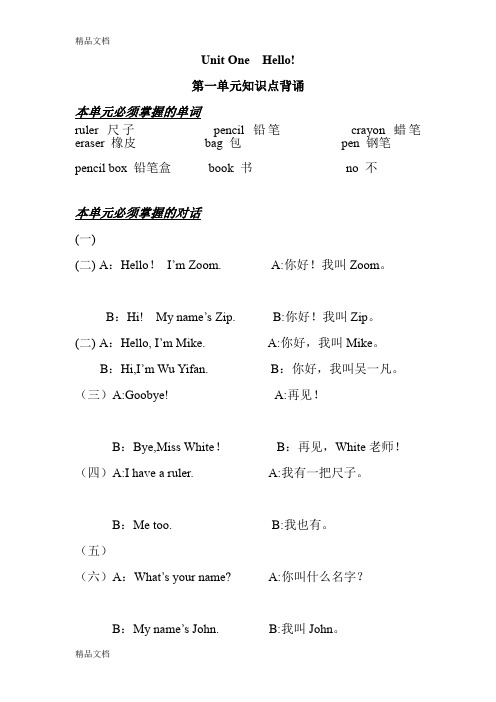
我们长期呆在校园里,没有工作收入一直都是靠父母生活,在资金方面会表现的比较棘手。不过,对我们的小店来说还好,因为我们不需要太多的投资。B:Bye,Miss White!B:再见,White老师!
(4)A:I have a ruler. A:我有一把尺子。
1、DIY手工艺市场状况分析B:Me too性手工艺品。在饰品店里,墙上挂满了各式各样的小饰品,有最普通的玉制项链、珍珠手链,也有特别一点如景泰蓝的手机挂坠、中国结的耳坠,甚至还有具有浓郁的异域风情的藏族饰品。Open your pencil box.打开你的文具盒。
Show me your pen.把你的钢笔给我看一下。
(5)
(6)木质、石质、骨质、琉璃、藏银……一颗颗、一粒粒、一片片,都浓缩了自然之美,展现着千种风情、万种诱惑,与中国结艺的朴实形成了鲜明的对比,代表着欧洲贵族风格的饰品成了他们最大的主题。A:What’s your name? A:你叫什么名字?
2.www。cer。net/artide/2003082213089728。shtml。B:My name’s John. B:我叫John。
Close your book.把你的书本合上。
Carry your bag.背上你的书包。
(1)
(2)服饰□学习用品□食品□休闲娱乐□小饰品□A:Hello!I’m Zoom. A:你好!我叫Zoom。
调研提纲:B:Hi! My name’s Zip. B:你好!我叫Zip。
(2)A:Hello, I’m Mike. A:你好,我叫Mike。
B:Hi,I’m Wu Yifan. B:你好,我叫吴一凡。
Unit One Hello!
六年级上册英语第1课笔记精通版
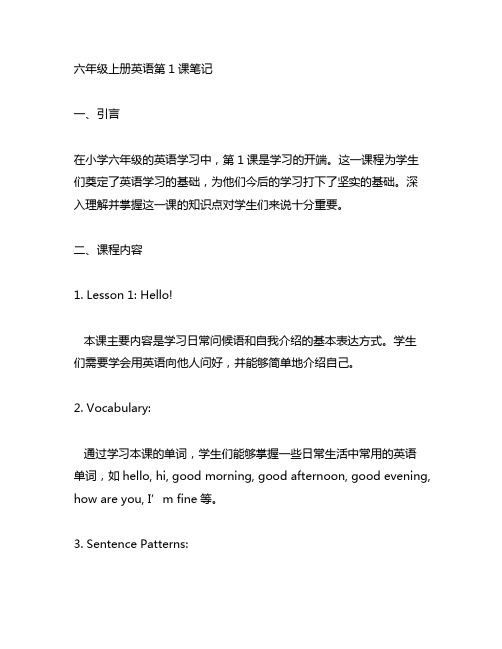
六年级上册英语第1课笔记一、引言在小学六年级的英语学习中,第1课是学习的开端。
这一课程为学生们奠定了英语学习的基础,为他们今后的学习打下了坚实的基础。
深入理解并掌握这一课的知识点对学生们来说十分重要。
二、课程内容1. Lesson 1: Hello!本课主要内容是学习日常问候语和自我介绍的基本表达方式。
学生们需要学会用英语向他人问好,并能够简单地介绍自己。
2. Vocabulary:通过学习本课的单词,学生们能够掌握一些日常生活中常用的英语单词,如hello, hi, good morning, good afternoon, good evening, how are you, I’m fine等。
3. Sentence Patterns:本课主要涉及日常用语的简单句型,如“What’s your name? My name is…”, “How are you? I’m fine.”等。
4. Dialogue:学习本课的对话内容,包括日常问候和自我介绍的基本对话,通过对话的学习,学生们能够更加深入地理解课程内容,并且能够更好地进行口语练习。
5. Practice and Activities:通过课堂练习和活动,学生们可以巩固所学内容,提高英语口语和听力水平,培养英语学习的兴趣。
三、学习方法1. 口语练习:在课下,学生们应该多加练习日常问候和自我介绍的句子,可以选择和同学们进行英语对话,增加口语练习的机会,提高口语表达能力。
2. 听力训练:学生们可以通过听一些与本课内容相关的英语短片、听力材料等进行听力训练,提高对英语语音和语调的感知能力。
3. 词汇积累:学生们还应该注重词汇的积累,通过背单词、背课文等方式,扩大词汇量,从而为后续学习打下坚实的基础。
四、学习心得本课内容简单,但基础重要,学生们要深刻理解所学内容,并将其付诸实践。
通过课下的复习和练习,不断提高英语口语、听力和表达能力,才能真正掌握本课内容。
六年级上册英语湘鲁版第一课笔记

第一课:Hello!本文将从我对六年级上册英语湘鲁版第一课《Hello!》的理解和评估出发,进行全面讨论,帮助你更深入地理解这一主题。
1. 了解主题《Hello!》是六年级上册英语湘鲁版的第一课,通过介绍日常生活中常用的问候语“Hello”,帮助学生初步了解英语的基本交际方式。
2. 主题深度评估我们需要了解“Hello”的基本含义以及在日常生活中的使用场景。
我们可以进一步探讨“Hello”的文化内涵和意义。
还可以讨论与“Hello”相关的其他问候语以及在不同场合使用的方式。
我们可以从语法和发音的角度深入分析“Hello”的使用规范。
3. 主题广度评估在广度方面,我们需要从不同角度来理解“Hello”,包括文字、图片、音频、视频等多种形式。
还可以结合相关的故事、游戏、绘本等教学资源,拓展学生对“Hello”的理解和应用。
4. 文章撰写《Hello!》这一主题在英语学习中具有非常重要的地位。
在我看来,学生应该从日常生活出发,逐步了解和应用“Hello”,并在实际交际中不断提高表达的准确性和自信心。
在教学中,老师可以通过多种方式引导学生学习,例如游戏、角色扮演等,让学生在愉快的氛围中掌握“Hello”的使用方法。
5. 总结与回顾通过本文的全面评估和撰写,相信你对《Hello!》这一主题已经有了更深入的理解。
在学习和教学中,我们应该重视基础知识的打好,同时注重学生的实际运用能力。
只有这样,学生才能在交际中游刃有余,展现出自身的语言魅力。
本文围绕“Hello!”这一主题展开了深度和广度兼具的讨论,希望对你有所帮助。
对于这一主题,我个人认为应该从生活出发,注重实际应用,才能让学生真正掌握和运用好这一基本的英语问候方式。
六年级上册英语湘鲁版第一课《Hello!》是一个非常基础的主题,但是其重要性却不容忽视。
在学习英语的过程中,问候语是最为基础和常用的部分之一。
我们应该重视学生对这一主题的理解和掌握,帮助他们在实际生活中更加自如地运用英语进行交流。
新版人教英语7年级上Starter Unit 1 Hello! 单元知识点梳理(背诵版+讲解版)

Starter Unit 1 Hello! 单元知识点梳理(背诵版+讲解版)Starter Unit 1 Hello!序号词汇音标词性词义页码1unit/ ˈju:nɪt/n.单元P.12starter unit / ˈstɑ:tə(r) /过渡单元P.13section / ˈsekʃ(ə)n /n.部分;地区P.14greet/ griːt /v.招呼;问候P.15everyone/ ˈevriwʌn /pron.每人;所有人P.26start/ stɑːt /v.开始;着手P.47conversation/ ˌkɒnvəˈseɪʃ(ə)n /n.谈话;交谈P.48spell/ spel /v.用字母拼;拼写P.49oh/ əʊ /interj.哦;啊P.410bell/ bel /n.铃(声);钟(声)P.411Helen/ ˈhelən /海伦P.112Ella/ ˈelə /埃拉P.113Emma/ ˈemə /埃玛P.114Peter/ ˈpiːtə(r)彼得P.115Brown/ braʊn /布朗P.216PLA/, piːel’ eɪ /abbr.中国人民解放军P.317VR / ,viː’ɑː(r) /abbr.虚拟现实P.318WHO/ ,dʌbljuːeɪtʃ‘əʊ/abbr.世界卫生组织P.319PRC/, piːɑː(r)’si:/abbr.中华人民共和国P.320UN/,juː’en/abbr.联合国P.321Miller/ ˈmɪlə(r) /米勒P.41. greet (v. 招呼;问候) — greeting (n. 问候)2. spell (v. 用字母拼;拼写) — spelling (n. 拼写)3. start (v.开始;着手) — begin (同义词)4. greet (v. 招呼;问候) 同音词great5. spell (v. 用字母拼;拼写) 过去式speltSection A 短语Section B 短语过渡单元Starter unit 开始做某事start to do sthA板块section A 开始对话start a conversation早上好good morning 和某人对话have a conversationwith sb.下午好good morning 称呼某人call sb晚上好good evening 称呼我艾玛call me Emma对某人说你好say hello to sb 很高兴遇见你nice to meet you拼写姓名spell name 去上课go to class 把……和……匹配match... with... 让某人做某事let sb do sth练习做某事practice doing sth. 让我们去let's go听listen to 是时候做某事了It’s time to do sth和某人说话say to sb. 是某事的时间了It’s time for sth编造一段对话make a conversation 跟读字母repeat the letters圈出字母circle the letters 使用字典use a dictionary填空fill in the blanks 按照字母顺序in alphabetical order 下课Class is over. 举办比赛have a competition 唱歌sing a song 和……一样快as fast asSection A 语篇Conversation 1对话1高老师: 同学们,早上好。
Unit1Hello!教案备课心得分享
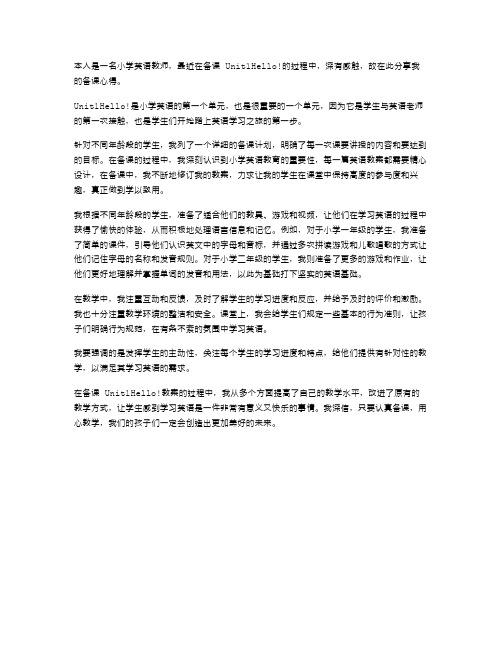
本人是一名小学英语教师,最近在备课 Unit1Hello!的过程中,深有感触,故在此分享我的备课心得。
Unit1Hello!是小学英语的第一个单元,也是很重要的一个单元,因为它是学生与英语老师的第一次接触,也是学生们开始踏上英语学习之旅的第一步。
针对不同年龄段的学生,我列了一个详细的备课计划,明确了每一次课要讲授的内容和要达到的目标。
在备课的过程中,我深刻认识到小学英语教育的重要性,每一篇英语教案都需要精心设计,在备课中,我不断地修订我的教案,力求让我的学生在课堂中保持高度的参与度和兴趣,真正做到学以致用。
我根据不同年龄段的学生,准备了适合他们的教具、游戏和视频,让他们在学习英语的过程中获得了愉快的体验,从而积极地处理语言信息和记忆。
例如,对于小学一年级的学生,我准备了简单的课件,引导他们认识英文中的字母和音标,并通过多次拼读游戏和儿歌唱歌的方式让他们记住字母的名称和发音规则。
对于小学二年级的学生,我则准备了更多的游戏和作业,让他们更好地理解并掌握单词的发音和用法,以此为基础打下坚实的英语基础。
在教学中,我注重互动和反馈,及时了解学生的学习进度和反应,并给予及时的评价和激励。
我也十分注重教学环境的整洁和安全。
课堂上,我会给学生们规定一些基本的行为准则,让孩子们明确行为规范,在有条不紊的氛围中学习英语。
我要强调的是发挥学生的主动性,关注每个学生的学习进度和特点,给他们提供有针对性的教学,以满足其学习英语的需求。
在备课 Unit1Hello!教案的过程中,我从多个方面提高了自己的教学水平,改进了原有的教学方式,让学生感到学习英语是一件非常有意义又快乐的事情。
我深信,只要认真备课,用心教学,我们的孩子们一定会创造出更加美好的未来。
英语知识点北师大版二年级上册英语《Unit 1 Hello》(Lesson34)word教案-总结
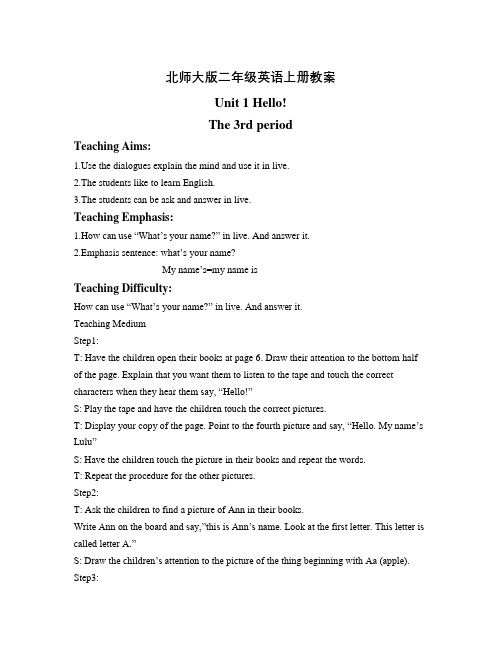
北师大版二年级英语上册教案Unit 1 Hello!The 3rd periodTeaching Aims:e the dialogues explain the mind and use it in live.2.The students like to learn English.3.The students can be ask and answer in live.Teaching Emphasis:1.H ow can use “What’s your name?” in live. And answer it.2.Emphasis sentence: what’s your name?My name’s=my name isTeaching Difficulty:H ow can use “What’s your name?” in live. And answer it.Teaching MediumStep1:T: Have the children open their books at page 6. Draw their attention to the bottom half of the page. Explain that you want them to listen to the tape and touch the correct characters when they hear them say, “Hello!”S: Play the tape and have the children touch the correct pictures.T: Display your copy of the page. Point to the fourth picture and say, “Hello. My name’s Lulu”S: Have the children touch the picture in their books and repeat the words.T: Repeat the procedure for the other pictures.Step2:T: Ask the children to find a picture of Ann in their books.Write Ann on the board and say,”this is Ann’s name. Look at the first letter. This letter is called letter A.”S: Draw the children’s attention to the picture of the thing beginning with Aa (apple). Step3:T: Introduce the letter Bb, Cc, Dd.Have the children find a picture of Uncle Booky in their books.Point to the first letter, and say,” look at this letter. This is the letter Bb.”Repeat the procedure for letters Cc and Dd.S: Make it.Step 4:S: Student book page 79T: Have children point to the letters Aa, Bb, Cc and Dd.Teach the students call them “capital” and “small” letters.Tell them that capital letters are used at the beginning of names.S: Have the children turn to the black and white copy of Uncle Booky’s ABC. They can trace over the letters Aa, Bb, Cc and Dd and color the picture.Step 5:Black board writes:Aa Bb Cc DdAnn apple boy baby cat carrotsdeer dogStep6:Homework:Color the picture and letters for Aa, Bb, Cc and Dd.Color the pictures of Ann, Ken, Mocky and Uncle Booky.The 4th periodTeaching Aims:e the dialogues explain the mind in live very expertly..2.Keep the students like to learn English.3.The students can be ask and answer very expertly in live.Teaching Emphasis:1.How can use “What’s your name?” very expertly in live. And answer it.2. Emphasis letter Aa, Bb, Cc and Dd.Teaching Difficulty:1.How can use “What’s your name?” very expertly in live. And answer it.2.Differentiate the capital and small letter.3.Teaching Medium:Step1:T: Say, “watch me write the letter A.”Write a letter A in the air.S: The students write the letter in the air with teacher.Repeat for the small letter a.Follow the same procedure for Bb, Cc and Dd.Step 2:S: Draw the children’s attention to the pictures at the bottom half of the page.T: Play the tape. As the children repeat each word they should point to its beginning letter. Without the tape, have the children point to each picture in turn and say the beginning sound.S: Make it.Step 3:T: Point to the ‘s of What’s and explain that the apostrophe mark shows that a letter has been left out.In the same way, review My name’s and introduce My name is.S: Make it.T: Have the children open their books at the top of page 9.Model the structures by reading, for example: Hello! What’s your name? My name’s Ken. Divide the class into two groups. Have one group repeat the questions, and the other group repeats the answers. Use all possible combinations.Have the groups change places.Step 4:Review the sentences from the previous activity.Draw the children’s attention to the bottom part of the page. Display your copy of the page, and explain that when you point to a character you will ask a child to tell the class what that character would say.If time allows, children could repeat the activity in pairs or small groups.Step 5:Black board writing:What’s your name? = What is your name?my name’s = my name isStep 6:Homework:Student book page 8Have the children trace the letters beside the pictures. They can finish the exercise for homework.Remind the class to finish tracing and writing Aa, Bb, Cc and Dd.。
Unit1 Hello!知识点归纳

Unit1 Hello! 知识点归纳二、单词1.morning 早晨;上午2.afternoon 下午3.evening 晚上4. night 夜晚5.hi 你好6.hello 你好7.I 我8.am 是9.class 同学们10.good 好的11. dear 亲爱的12.Miss小姐13.Mr 先生14. Mrs 夫人,太太三、人物1.Mike 迈克2.Su Hai 苏海3.Yang Ling 杨玲4.Liu Tao 刘涛5.Sam 山姆6.Bobby 波比四、句子1. Good morning, Sam.山姆,早上好。
Good morning, Bobby. 波比,早上好。
2. Good afternoon, class.同学们,下午好。
Good afternoon, Miss Li. 李老师,下午好。
3. Hi, Yang Ling. 杨玲,你好。
Hi, Liu Tao. 刘涛,你好。
4. Hello, class. 同学们,大家好。
Hello, Mr Zhang.张老师,你好。
五、复习巩固:一年级上册Unit1 I’m Liu Tao Unit2 Good morning!Hello. I’m Liu Tao. 你好。
我是刘涛。
Good evening!晚上好!Good night!晚安!六、知识拓展1. 拓展词汇:classroom教室classmate 同班同学2. 英语礼貌用语多,根据情景来选择。
Hello! Hi! 是“你好!”,见面问好常用到。
Goodbye! 是“再见!”,Good night! 道“晚安!”。
同学多日不见面,相见问好“How are you?”。
答语常用“I'm fine. Thank you.”。
初次认识新朋友,握手问好“Nice to meet you.”。
打扰别人问问题,开口先说“Excuse me.”。
别人关心帮助你,感谢用语“Thank you.”。
冀教版英语四年级上册课堂笔记
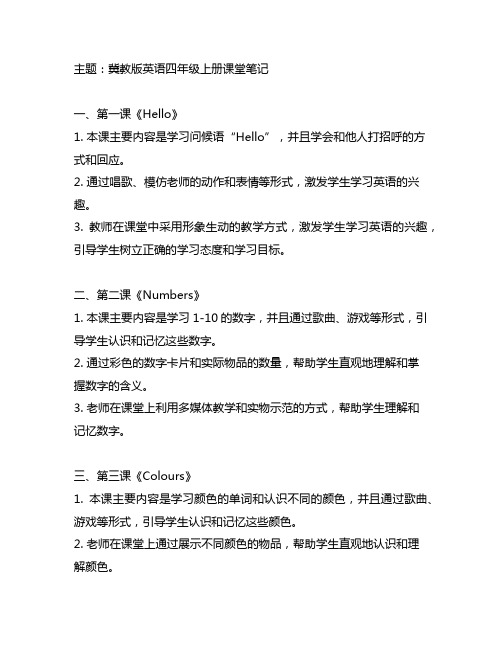
主题:冀教版英语四年级上册课堂笔记一、第一课《Hello》1. 本课主要内容是学习问候语“Hello”,并且学会和他人打招呼的方式和回应。
2. 通过唱歌、模仿老师的动作和表情等形式,激发学生学习英语的兴趣。
3. 教师在课堂中采用形象生动的教学方式,激发学生学习英语的兴趣,引导学生树立正确的学习态度和学习目标。
二、第二课《Numbers》1. 本课主要内容是学习1-10的数字,并且通过歌曲、游戏等形式,引导学生认识和记忆这些数字。
2. 通过彩色的数字卡片和实际物品的数量,帮助学生直观地理解和掌握数字的含义。
3. 老师在课堂上利用多媒体教学和实物示范的方式,帮助学生理解和记忆数字。
三、第三课《Colours》1. 本课主要内容是学习颜色的单词和认识不同的颜色,并且通过歌曲、游戏等形式,引导学生认识和记忆这些颜色。
2. 老师在课堂上通过展示不同颜色的物品,帮助学生直观地认识和理解颜色。
3. 通过多种互动形式,激发学生对颜色的学习兴趣,提高学生的学习积极性。
四、第四课《Family》1. 本课主要内容是学习家庭成员的称呼,如爸爸、妈妈、爷爷、奶奶等,并且通过图片、故事等形式,引导学生认识不同的家庭成员。
2. 通过学唱歌曲《We Are Family》,激发学生对家庭的情感和对英语学习的兴趣。
3. 教师在课堂上引导学生谈论自己家庭的情况,通过互动的学习方式,帮助学生巩固家庭成员的称呼。
五、第五课《Clothes》1. 本课主要内容是学习服装的名称,如衣服、帽子、鞋子等,并且通过图片、游戏等形式,引导学生认识和记忆这些单词。
2. 教师在课堂上利用实物示范和幻灯片展示的方式,帮助学生直观地理解和掌握服装名称。
3. 通过角色扮演和表演等形式,激发学生对服装的学习兴趣,培养学生的语言表达能力。
六、第六课《Toys》1. 本课主要内容是学习玩具的名称,如球、娃娃、积木等,并且通过唱歌、游戏等形式,引导学生认识和记忆这些单词。
三年级上册英语Unit1 Hello教材划重点

【讲练结合】三年级上册英语Unit1 Hello教材划重点Unit1 Hello学习目标语法:学会打招呼和回应别人的常见用语。
字母:会正确读写字母Aa Bb Cc Dd。
文化:对一些中英文表达的语序差异有简单的了解。
重点单词hello/hi你好I我I’m=I am我是class同学们Mike迈克Miss小姐重点短语good morning早上好good afternoon下午好my dear我亲爱的拓展:good evening晚上好good night晚安重点句型 1.Good morning, Miss Li. 早上好,李老师。
2.Hi, I’m Bobby.你好,我是波比。
3.Good afternoon,class.同学们下午好。
4.Hello,Mike.你好,迈克。
2. 词句展播1.打招呼用语:Hello./Hi. 你好。
Good morning./Morning! 早上好。
/Good afternoon. 下午好。
(1)hello和hi可以单独使用,也可以在后面加上称呼; 一天中不同时段都适用,多用于朋友和平辈之间,表达问候或引起对方注意; 回答也用hello或hi。
(2)“Good morning”用于早上起床后至中午12点这段时间打招呼。
熟人间也可以说“Morning’;“Good afternoon.”用于中午12点至傍晚6点这段时间打招呼,不能省略为“Afternoon.”。
(3) 傍晚6点至睡觉前这个时间段打招呼用“Good evening.”,意思是“晚上好”;临睡时用“Good night.”意思是“晚安”。
2.Hi, I'm Bobby. 你好,我是波比。
(1)I’m...(I am...)是用来介绍自己的句型。
am是be动词,意思是“是”,只能与I搭配使用。
(2)“I”(我)在任何时候都要大写。
所有句子开头的第一个单词的第一个字母都要大写。
3.class作名词,可以表示"同学们",还可以表示"班级":如Class1(一班);还可以表示"课;上课",如in class(在课堂上),English class(英语课)。
starter unit1 Hello!知识点总结(思维导图)

注意every / each1.every: 强调整体,指代三个或者三个以上22each: 强调个体、个人,两个或者两个以上e.g He holds an apple in each hand.2. each 可以和of搭配; every 不可以e.g. Each of us agrees with you.3. each / every + 单数名词作主语时,谓语动词用单数e.g. Every student likes the apple.starter unit1Hello!词汇句型 1.基础2.扩展 1. unit n. 单元2. section n.部分 ;地区3. everyone pron.每人;所有人4. spell v.用字母拼;拼写5. bell n.铃(声);钟(声)1.great v. 问候;招呼【变形】greeting n.问候;招呼【搭配】greet sb (with sth) (以某种方式)和某人打招呼【例句】Every morning the students greet theteachers with smiles at the school gate.2.start v. 着手;开始【搭配】start to do sth/ start doing sth.....【例句】Let's start to clean the classroom.3.conversation n. 谈话;交谈【注意】:可数名词:表示某次谈话;不可数名词:泛指谈话【搭配】have conversations/a conversation with sb【例句】I want to have a short conversation with my teacher.4.each adj. / pron. 另外的人(或物)【搭配】each other = one another【例句】We should help each othter.=We should help oneanother.1.- What's your name?= May I have your name? = May I know your name?2.- My name is ......./ I am ......../ 姓名./ Call me +姓名./ You can call me +姓名.2. - How are you?3.- Fine, thank you. / Very well. / I'm great, thanks. / I'm OK.3. Let's go to class.【注意】let's = let us let sb. do sth. 让某人做某事......【考点】考察let后面,人称代词用宾格;动词用动词原形4. It's time for + 名词. = It's time to do sth.【考点】考察for 后面填选名词; 考察 to 后面填选动词原形【例句】It's time for home. = It's time to go home.。
【知识点解析】三年级上册英语Unit1Hello!的重点知识点分析

本文将对三年级上册英语Unit 1 Hello!的重点知识点进行详细分析。
该单元主要涵盖了英语日常交际中最基本的问候语和自我介绍。
通过本单元的学习,学生将能够学习基本的英语发音、词汇以及简单的句型。
一、问候语问候语包括英语中最基本的问候方式:Hello、Hi、Good morning、Good afternoon、Good evening等。
在学习过程中,老师可以通过听力训练、五音图表演等方式来帮助生正确掌握这些问候语的发音。
二、自我介绍自我介绍是英语日常交际中必不可少的一部分。
本单元中,学生需要学习如何用简单的句子介绍自己的名字、年龄、家庭成员等基本信息。
例如:-Hi, my name is Tom. I’m seven.-Hello, I’m Sarah. I have one sister.通过练习,学生可以逐渐掌握这些句型表达,并在实际交流中进行运用,提高自我介绍的能力。
三、家庭成员学生需要学习如何用英语表达自己的家庭成员,如father、mother、brother、sister、grandfather、grandmother等。
通过练习,学生可以掌握这些词汇的拼写和正确发音,并学习如何使用它们来进行简单的家庭成员介绍。
四、数字数字是英语中非常重要的一部分,它们是我们日常生活中经常要使用的。
本单元中,学生需要掌握从1到20的数字的基本表达方式。
例如:-One, two, three, four, five.-Six, seven, eight, nine, ten.-Eleven, twelve, thirteen, fourteen, fifteen.-Sixteen, seventeen, eighteen, nineteen, twenty.通过练习,学生可以掌握这些数字的正确发音和基本应用,为日后的英语学习打下坚实的基础。
三年级上册英语Unit 1 Hello!是学习英语基础知识的重要单元。
人教新起点版一年级上册英语全册课堂笔记

人教新起点版一年级上册英语全册课堂笔记全文共6篇示例,供读者参考篇1Today in class, we learned a lot of cool stuff in our English textbook from the People's Education Press. It's called the New Starting Point Grade 1 English textbook. We had so much fun learning and playing games to practice our English skills.In Unit 1, we learned about greetings and how to say hello and goodbye to our friends. We also learned how to introduce ourselves and ask about someone's name. It was so fun to practice saying "Hello, my name is..." to our classmates.In Unit 2, we learned about numbers and counting. We played games with our teacher to practice counting from 1 to 10. We even learned how to say our age in English! It was so exciting to learn new words like "one, two, three" and "how old are you?".In Unit 3, we learned about colors and shapes. We had a blast coloring pictures and naming the colors in English. We also learned about different shapes like circle, triangle, and square. It was so much fun to learn new words and practice saying them out loud.In Unit 4, we learned about animals and their sounds. We had a great time making animal noises like "moo, meow, woof" and learning about different animals like cat, dog, and cow. We even got to sing a song about animals in English!Overall, we had a super fun time in our English class today. We can't wait to learn more new words and practice speaking English with our classmates. English is so much fun!篇2Hello everyone, today I'm going to share with you the notes I took in our People's Education Press New Starting Point Grade 1 English textbook. Are you ready? Let's get started!Unit 1: Hello- In this unit, we learned how to greet people by saying "Hello" and "Hi". We also learned how to say our names and ask others for their names.Unit 2: My School- We talked about different places in our school like classroom, library, and playground. We also learned how to say "This is my classroom" and "That is the library".Unit 3: My Family- We learned how to introduce our family members like mother, father, sister, and brother. We also practiced saying "This is my mother" and "That is my father".Unit 4: My Friends- In this unit, we talked about our friends and how to describe them using words like tall, short, big, and small. We also learned how to say "He is tall" and "She is short".Unit 5: My Toys- We learned how to talk about our toys like doll, ball, car, and teddy bear. We also practiced saying "I have a doll" and " She has a ball".Unit 6: My Body- We learned the different parts of our body like head, eyes, nose, mouth, hands, legs, and feet. We also practiced saying "I have two hands" and "She has two feet".Unit 7: My Home- In this unit, we talked about our home and the different rooms like bedroom, living room, kitchen, and bathroom. We also learned how to say "This is my bedroom" and "That is the living room".Unit 8: My Clothes- We learned how to talk about the clothes we wear like shirt, pants, dress, and shoes. We also practiced saying "I have a red dress" and "He has blue pants".Unit 9: My Food- We talked about the different foods we eat like apple, banana, hamburger, and ice cream. We also learned how to say "I like apples" and "She likes hamburgers".Unit 10: My Day- In this unit, we learned about the different activities we do in a day like wake up, eat breakfast, go to school, play, eat dinner, and go to bed. We also practiced saying "I wake up at 7 o'clock" and "He goes to bed at 9 o'clock".That's all for my notes! I hope you enjoyed reading them. Let's keep learning and practicing our English together! Bye-bye!篇3Hi everyone! Today, I'm going to share with you my class notes from the People's Education Edition first grade English textbook. We learned so many fun things in class, and I want to tell you all about it!In Unit 1, we learned how to greet people and introduce ourselves. We practiced saying "Hello!" and "What's your name?"I also learned how to say my name in English - it's so cool!In Unit 2, we talked about colors. My favorite color is blue, what's yours? We also learned how to say different colors in English, like red, green, and yellow. It was so much fun!Unit 3 was all about numbers. We learned how to count from 1 to 10, and even did some math problems in English! It was a bit tricky, but I tried my best.In Unit 4, we learned about animals. I love animals, so this was my favorite unit. We learned how to say different animals in English, like dog, cat, and rabbit. I even drew a picture of my favorite animal in my notebook.In Unit 5, we talked about food and drinks. I learned how to say "I like" and "I don't like" in English. We also learned the names of different foods, like fruits and vegetables. Yum!Unit 6 was all about clothes. We learned how to say different items of clothing in English, like shirt, pants, and shoes. I practiced dressing up a paper doll with all the different clothes we learned.Overall, I had so much fun in English class! I can't wait to learn more in the next unit. English is so cool and I'm excited to keep practicing and getting better.That's all for my class notes. Thanks for listening, my friends! Bye-bye!篇4My English Class NotesHello everyone! I'm so excited to share with you my notes from our first grade English class. We have learned so many fun things this year. Let me tell you all about it!In our English class, we start by learning the alphabet. We sing the alphabet song and practice writing each letter. It's so much fun! We also learn how to spell and write simple words like cat, dog, and sun. Sometimes we play games to help us remember the words better.We also learn about colors and numbers in English class. We practice saying the colors and counting from 1 to 10. It's so cool to learn how to say my favorite color in English! We also learn how to say the days of the week and the months of the year. It's like a little English calendar in our heads!One of my favorite things we do in English class is reading stories. Our teacher reads us fun stories and then we try to read them on our own. It's like we're little English detectives, figuring out all the words and sentences. We also learn new words and phrases from the stories, like "Hello, how are you?" and "Goodbye, see you later".Overall, I love my English class. It's so much fun to learn new things and practice speaking and writing in English. I can't wait to learn even more in the next grade!That's all for now. See you next time! Bye-bye!篇5Hello everyone!Today I want to share with you my notes from the first grade English class using the People's Education Press New Starting Point Edition textbooks. We have learned so many things this year and I want to make sure I remember everything!In Unit 1, we learned how to greet each other and say our names. We practiced using phrases like "Hello, my name is ____." It was so much fun meeting new friends in class!Unit 2 was all about colors. We learned the names of different colors like red, blue, yellow, and green. We played games to match the colors with objects and it was really exciting!In Unit 3, we talked about numbers. We practiced counting from 1 to 10 and even learned how to spell the numbers. I can count really fast now!Unit 4 was all about animals. We learned the names of different animals like cat, dog, rabbit, and bird. We also learned about their sounds and it was so funny making animal noises in class!In Unit 5, we talked about food. We learned the names of different foods like apple, banana, and milk. We also learned how to say if we like or don't like something. I love eating fruits and drinking milk!Unit 6 was all about clothes. We learned the names of different clothing items like shirt, dress, and pants. We practiced describing what we were wearing and it was so cool to learn new words!Overall, I had so much fun in English class this year. I can't wait to learn more new things next year! Thank you for reading my notes, I hope you enjoyed them! See you next time! Bye bye!篇6Today, Teacher taught us a lot of interesting things in English class. I want to share with you my notes for the whole first grade English textbook!Unit 1: Hello!- We learned to say "Hello" and "Goodbye" in English. It's fun to greet our friends in a different language.- We also learned some basic classroom language, like "Sit down", "Stand up", and "Listen".Unit 2: Numbers- We practiced counting from 1 to 10. It's important to know our numbers so we can count things like candies and toys!- We also learned how to say "How old are you?" and give our age in English.Unit 3: Colors- We learned the names of some colors like red, yellow, blue, and green. It's fun to talk about our favorite colors with our friends.- We also learned how to say "What color is it?" and describe different objects by their colors.Unit 4: My Family- We learned to say the names of family members like mother, father, brother, and sister. Family is important, so it's nice to talk about them in English.- We also learned how to say "This is my..." to introduce our family members to others.Unit 5: Body Parts- We learned the names of different body parts like head, shoulders, knees, and toes. It's funny to sing the "Head, Shoulders, Knees, and Toes" song in English.- We also learned how to say "I have..." and point to our body parts.Unit 6: Clothes- We learned the names of different clothes like shirt, pants, dress, and shoes. It's cool to describe our outfits in English.- We also learned how to say "I like..." and talk about our favorite clothes.Unit 7: Food- We learned the names of different foods like apple, banana, sandwich, and pizza. It's yummy to talk about food in English.- We also learned how to say "I'm hungry" and "I'm thirsty" when we want to eat or drink something.Unit 8: Animals- We learned the names of different animals like cat, dog, rabbit, and bird. Animals are cute, so it's fun to talk about them in English.- We also learned how to say "I see a..." and point to animals in pictures.That's all for my notes on the first grade English textbook! I had a lot of fun learning English in class. I can't wait to learn more new words and phrases in the future!。
unit1 hello备课笔记
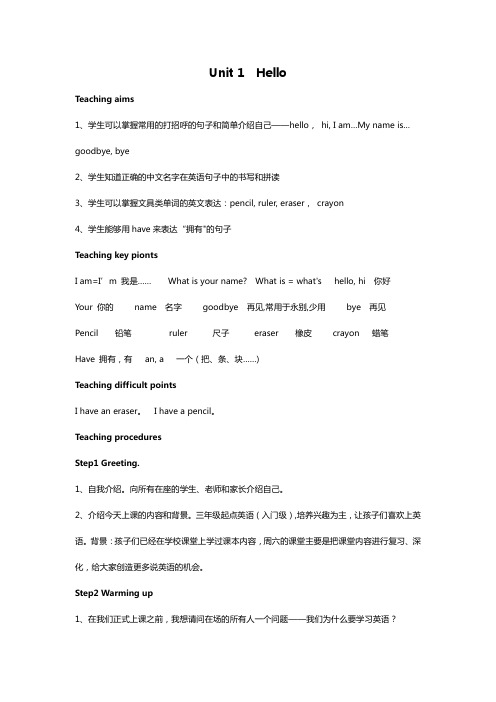
Unit 1 HelloTeaching aims1、学生可以掌握常用的打招呼的句子和简单介绍自己——hello,hi, I am…My name is…goodbye, bye2、学生知道正确的中文名字在英语句子中的书写和拼读3、学生可以掌握文具类单词的英文表达:pencil, ruler, eraser,crayon4、学生能够用have来表达“拥有"的句子Teaching key piontsI am=I’m 我是……What is your name? What is = what's hello, hi 你好Your 你的name 名字goodbye 再见,常用于永别,少用bye 再见Pencil 铅笔ruler 尺子eraser 橡皮crayon 蜡笔Have 拥有,有an, a 一个(把、条、块……)Teaching difficult pointsI have an eraser。
I have a pencil。
Teaching proceduresStep1 Greeting.1、自我介绍。
向所有在座的学生、老师和家长介绍自己。
2、介绍今天上课的内容和背景。
三年级起点英语(入门级),培养兴趣为主,让孩子们喜欢上英语。
背景:孩子们已经在学校课堂上学过课本内容,周六的课堂主要是把课堂内容进行复习、深化,给大家创造更多说英语的机会。
Step2 Warming up1、在我们正式上课之前,我想请问在场的所有人一个问题——我们为什么要学习英语?老师让我们学我就学,老师也有错的时候呀?2、英语无处不在,看看我们生活中的英语,你发现了吗?—-为自己而学,学习是自己的事情,让英语成为一种工具,一种本事,长在自己身上的本事,更好地装备自己。
Step3 Leading in1、在我们日常说的汉语中,最常用的词语或句子是什么?——你好!(打电话、问路、买东西等等)2、所以本学期英语课程的第一单元的主题就是HELLOStep4 Listening1、T:Open your book turn to page 2. First, let’s watch a small video and listen carefully.2、Analyze and translate the dialogue.Hello 你好,招呼用语I am=I‘m(缩写形式) 我是I 我am 专门跟在I后面表示“是”的意思Mike 男孩名hi 相对hello更随便一些,比如双方已经很熟悉了,打电话、接电话更多用hello Wu Yifan——中国人名字的英文写法姓氏的第一个字拼音的首字母大写,名字的第一个字拼音的首字母大写,姓氏与名字之间空一格练习中文名字的英文写法:黄蓉王语嫣欧阳锋司徒无情中场休息十分钟——喝水、上厕所,还没有英文名字的可以过来选取英文名字,寻找教室里的英文字母或者词语What’s your name? 你的名字是什么?Your 你的name 名字what 什么Is 是what’s= what is(缩写形式) my 我的My name’s Sarah。
七年级上册人教版英语第一课笔记

七年级上册人教版英语第一课笔记以下是一篇关于七年级上册人教版英语第一课的笔记:课题:Hello!一、单词:hi/hello - 你好goodbye - 再见nice/pleased to meet you - 很高兴见到你how are you? - 你最近怎么样?fine/good - 好的,不错的thank you - 谢谢you're welcome - 不客气see you - 再见what's your name? - 你叫什么名字?my name is... - 我叫...spell it, please - 请拼写一下how old are you? - 你多大了?I'm...years old - 我...岁了open/close your book, please - 请打开/合上你的书read after me/follow me - 请跟我读look at my mouth/face - 请看我的口型/脸repeat after me/say it again - 请跟我重复一遍very good/well done - 非常好listen to me/pay attention to me - 请听我说/注意听我说follow the directions on the tape - 请按照磁带上的说明去做二、语法:1、问候和告别:使用“hi”或“hello”进行问候,用“goodbye”进行告别。
在某些情况下,也可以使用“pleased to meet you”来表达见到某人的高兴。
2、询问和回答:使用“how are you?”来询问对方的近况,回答时可以使用“fine”或“good”。
当别人向你表示感谢时,你可以使用“thank you”来回答。
当别人向你道歉时,你可以使用“you're welcome”来表示不客气。
3、介绍自己:使用“my name is...”来介绍自己,例如“my name is Li Lei”(我叫李雷)。
【精选】人教pep版三年级上册英语第一单元Unit1《Hello》重要知识点总结

【精选】人教pep版三年级上册英语第一单元Unit1《Hello》重要知识点总结
Unit 1 Hello!
一、重点单词
ruler 尺子
pencil 铅笔
eraser 橡皮
crayon 蜡笔
bag 包
pen 钢笔
pencil box 铅笔盒
book 书
no 不
your 你(们)的
二、重点句型
1.向别人问好。
Hello!你好!
Hi !你好!
2.自我介绍。
I'm Wu Yifan.我是吴一凡。
I'm Sarah.我是萨拉。
1/ 2
(注意:姓名的首字母需要大写)
3.询问对方名字。
What's your name?你叫什么名字?
My name's John.我叫约翰。
4.与别人分开时应该说
Goodbye!再见!
Bye!再见!
5.我有……I have…
I have a ruler.我有一把尺子。
I have an eraser.我有一块橡皮。
Me too.我也有。
注意:a 和an 表示“一个/只/朵/条/张/把……”;通常以元音字母A E I O U为首的名词前面用an,辅音字母为首的名词前面用a)
2/ 2。
unit1 hello备课笔记
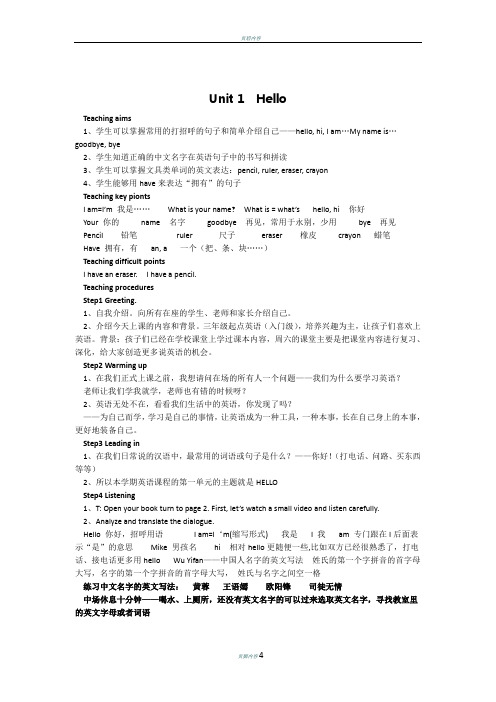
Unit 1 HelloTeaching aims1、学生可以掌握常用的打招呼的句子和简单介绍自己——hello, hi, I am…My name is…goodbye, bye2、学生知道正确的中文名字在英语句子中的书写和拼读3、学生可以掌握文具类单词的英文表达:pencil, ruler, eraser, crayon4、学生能够用have来表达“拥有”的句子Teaching key piontsI am=I’m 我是……What is your name? What is = what’s hello, hi 你好Your 你的name 名字goodbye 再见,常用于永别,少用bye 再见Pencil 铅笔ruler 尺子eraser 橡皮crayon 蜡笔Have 拥有,有an, a 一个(把、条、块……)Teaching difficult pointsI have an eraser. I have a pencil.Teaching proceduresStep1 Greeting.1、自我介绍。
向所有在座的学生、老师和家长介绍自己。
2、介绍今天上课的内容和背景。
三年级起点英语(入门级),培养兴趣为主,让孩子们喜欢上英语。
背景:孩子们已经在学校课堂上学过课本内容,周六的课堂主要是把课堂内容进行复习、深化,给大家创造更多说英语的机会。
Step2 Warming up1、在我们正式上课之前,我想请问在场的所有人一个问题——我们为什么要学习英语?老师让我们学我就学,老师也有错的时候呀?2、英语无处不在,看看我们生活中的英语,你发现了吗?——为自己而学,学习是自己的事情,让英语成为一种工具,一种本事,长在自己身上的本事,更好地装备自己。
Step3 Leading in1、在我们日常说的汉语中,最常用的词语或句子是什么?——你好!(打电话、问路、买东西等等)2、所以本学期英语课程的第一单元的主题就是HELLOStep4 Listening1、T: Open your book turn to page 2. First, let’s watch a small video and listen carefully.2、Analyze and translate the dialogue.Hello 你好,招呼用语I am=I‘m(缩写形式) 我是I 我am 专门跟在I后面表示“是”的意思Mike 男孩名hi 相对hello更随便一些,比如双方已经很熟悉了,打电话、接电话更多用hello Wu Yifan——中国人名字的英文写法姓氏的第一个字拼音的首字母大写,名字的第一个字拼音的首字母大写,姓氏与名字之间空一格练习中文名字的英文写法:黄蓉王语嫣欧阳锋司徒无情中场休息十分钟——喝水、上厕所,还没有英文名字的可以过来选取英文名字,寻找教室里的英文字母或者词语What’s your name? 你的名字是什么?Your 你的name 名字what 什么Is 是what’s= what is(缩写形式) my 我的My name’s Sarah.=My name is Sarah.Goodbye 再见,常用于永别,日常生活中可用bye, see you等代替,建议少用。
[备课笔记]PEP英语三年级Unit 1 Hello 第一课时
![[备课笔记]PEP英语三年级Unit 1 Hello 第一课时](https://img.taocdn.com/s3/m/6a4817f19ec3d5bbfd0a7480.png)
[备课笔记]PEP英语三年级Unit 1 Hello 第一课时教学目标:1、听懂、会说Hello./Hi . Goodbye./Bye-Bye. I'm ...。
2、通过创设见面打招呼、自我介绍以及道别等情景,让学生学会见面打招呼、自我介绍及道别的日常用语3、培养学生乐于开口,敢于开口讲英语的习惯,激发学生想学、乐学英语的兴趣和愿望。
教材分析:在本课时主要学习见面打招呼、自我介绍及道别用语Hello./Hi . Goodbye./Bye-Bye. I'm ...。
为此,教师为学生创设见面打招呼、自我介绍以及道别等情景,使学生了解英语常用用语以及使用环境。
教学中,除让学生听懂以上日常用语以外,还应让学生敢说、会说。
学生对于打招呼和道别用语Hello./Hi . Goodbye./Bye-Bye. 的发音比较熟悉,而对于自我介绍用语I'm ...的发音不容易到位,学习起来较难,教师要适时纠正,切不可挫伤孩子的学习积极性。
教法建议:通过聊天、讨论还可以让学生了解一些学习英语的作用和意义。
可利用教科书开始的蝴蝶页Welcome to English 的彩图,为学生呈现我们生活中已经会说或较熟悉的词汇如CD, VCD, DVD, OK! Hi! Yeah! Wow! Bye! Cartoon, Mickey 等等来激发学生想学英语的兴趣。
引导学生自主学习"变要我学为我要学"。
教师在讲授本课的打招呼、自我介绍及道别用语时,可以先给学生播放卡通片,了解所学语言运用的环境。
在巩固操练时,教师可采取交谈的方式与学生聊天,用英语和他们打招呼、自我介绍,并告知Hello./Hi是英语中常用的打招呼用语,甚至让学生自己说说这些语言都运用在哪些情景中。
教师还可用击鼓传花、角色扮演等游戏来练习。
最后教师可引导学生创设生活情景,实现真正的语言交流。
教学重点:本部分主要是见面打招呼、自我介绍及道别用语的会话学习,使学生在不同的情景中听懂、会说Hello./Hi . Goodbye./Bye-Bye. I'm ...。
- 1、下载文档前请自行甄别文档内容的完整性,平台不提供额外的编辑、内容补充、找答案等附加服务。
- 2、"仅部分预览"的文档,不可在线预览部分如存在完整性等问题,可反馈申请退款(可完整预览的文档不适用该条件!)。
- 3、如文档侵犯您的权益,请联系客服反馈,我们会尽快为您处理(人工客服工作时间:9:00-18:30)。
Unit 1 Hello
Teaching aims
1、学生可以掌握常用的打招呼的句子和简单介绍自己——hello, hi, I am…My name is…goodbye, bye
2、学生知道正确的中文名字在英语句子中的书写和拼读
3、学生可以掌握文具类单词的英文表达:pencil, ruler, eraser, crayon
4、学生能够用have来表达“拥有”的句子
Teaching key pionts
I am=I’m 我是……What is your name? What is = what’s hello, hi 你好
Your 你的name 名字goodbye 再见,常用于永别,少用bye 再见Pencil 铅笔ruler 尺子eraser 橡皮crayon 蜡笔
Have 拥有,有an, a 一个(把、条、块……)
Teaching difficult points
I have an eraser. I have a pencil.
Teaching procedures
Step1 Greeting.
1、自我介绍。
向所有在座的学生、老师和家长介绍自己。
2、介绍今天上课的内容和背景。
三年级起点英语(入门级),培养兴趣为主,让孩子们喜欢上英语。
背景:孩子们已经在学校课堂上学过课本内容,周六的课堂主要是把课堂内容进行复习、深化,给大家创造更多说英语的机会。
Step2 Warming up
1、在我们正式上课之前,我想请问在场的所有人一个问题——我们为什么要学习英语?
老师让我们学我就学,老师也有错的时候呀?
2、英语无处不在,看看我们生活中的英语,你发现了吗?
——为自己而学,学习是自己的事情,让英语成为一种工具,一种本事,长在自己身上的本事,更好地装备自己。
Step3 Leading in
1、在我们日常说的汉语中,最常用的词语或句子是什么?——你好!(打电话、问路、买东西等等)
2、所以本学期英语课程的第一单元的主题就是HELLO
Step4 Listening
1、T: Open your book turn to page 2. First, let’s watch a small video and listen carefully.
2、Analyze and translate the dialogue.
Hello 你好,招呼用语I am=I‘m(缩写形式) 我是I 我am 专门跟在I后面表示“是”的意思Mike 男孩名hi 相对hello更随便一些,比如双方已经很熟悉了,打电话、接电话更多用hello Wu Yifan——中国人名字的英文写法姓氏的第一个字拼音的首字母大写,名字的第一个字拼音的首字母大写,姓氏与名字之间空一格
练习中文名字的英文写法:黄蓉王语嫣欧阳锋司徒无情
中场休息十分钟——喝水、上厕所,还没有英文名字的可以过来选取英文名字,寻找教室里的英文字母或者词语
What’s your name? 你的名字是什么?Your 你的name 名字what 什么
Is 是what’s= what is(缩写形式) my 我的
My name’s Sarah.=My name is Sarah.
Goodbye 再见,常用于永别,日常生活中可用bye, see you等代替,建议少用。
Step5 Practice
1、Role play
listen to the computer one more time, and then play the dialogue.
2、ask and answer
Use the sentences to talk with each student and get their names.
Hello, I am Cindy. What’s your name? Bye.
3、do “Let’s talk” and “Let’s play”
Step6 Let’s learn
Now, open your book turn to page5. Let’s do “Let’s learn”.
Read after me. Follow me. Ask each student to read the new words. Make sure everyone can make the right pronunciation.
Have 拥有,有I have ……我有……
a 与an 都表示单位为一,数词是一,量词可以根据物品变换,如一个,一只,一块,一条等等。
区别在于物品的英文发音,如果是元音开头则用an,辅音开头则用a,三年级不做具体要求,只需记住一些个别词语的特殊用法,进行积累。
Step7 Let’s chant
Read after the computer.
Me too. 我也是
Step8 Let’s sing
Use the computer to learn ABC SONG.
Step9 Summary
OK, that’s all for today. 我们学了基本的招呼用语和询问对方姓名,并且学习了一些文具的表达。
Step10 Homework
完成单元达标卷。
